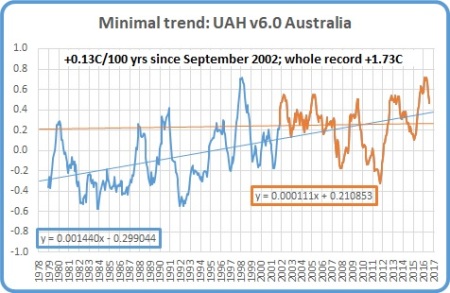(With thanks to Lance, Phill, and others)
A week ago, a colleague alerted me to strange behaviour at an Automatic Weather System at Borrona Downs in NSW. This is a brand new weather station, with its first observation on 21 July.
Phill writes in an email: Do you ever wonder why you get a shiver down your spine? Pity the poor folks in the NSW far west.
From this mornings (20th August) NSW observation list: The minimum temperature at Borrona Downs AWS was -62.5C at 9:59pm last night. Probably some clowns with a bucket of dry ice or liquid nitrogen. Perhaps Odin’s host crossed the night sky or maybe death just walked on by… The individual reads don’t show anything lower than -37.5C also at 9:59 so the cold spike was quite sudden. It went from -62.5C sometime between 21:58:00 and 21:59:00 to -37.5C at exactly 21:59:00 to -4.4C at 22:00:00.
I was too busy and preoccupied until now to follow this up, but I have a few days now.
Borrona Downs Station is in sandhill and claypan country in the far northwest of NSW:


Here is the Climate Data Online minima record (note minima indicated on two days):

The following plots show the deterioration in the performance of the AWS. Firstly, the comparison with Tibooburra, 110km away, showing a sudden change at 29 July: Subtracting Borrona Downs data from Tibooburra shows that Borrona Downs Tmin is too high from this date. The whole (brief) record should be scrapped.

But the devil, as Phill found, is in the detail. Here is part of the record for the 19th: Note the Low Temp at 9.59 pm, and I have indicated the official minimum for the day which would have occurred early that morning.

The Bureau has the minimum at 4.6C, but how was this value obtained? The erroneous values, (including that of liquid nitrogen), are flagged, then manually removed, and the previous lowest temperature is retrieved from the one minute data for the day. This also happened on the 26th:

Things got much worse on August 27th:

Why could no minimum be found? Did the BOM realise that none of the data were reliable, and were essentially random errors? Remember that the AWS records values every second, and the highest, lowest, and final second values for each minute are stored. My guess is that many of these values were unreliable as well, even though many of the final second half hour values seem reasonable- for example 4.4C at 5.30 am.
This continued on August 28th with an all time low of -69.5C:
And the BOM ceased reporting values at 3:30 pm.
This description of events was confirmed by the Bureau’s response to a query:
“Do you know what is causing the very low temperature recordings?
There is a hardware fault within the AWS which is generating spurious values. The Bureau’s technicians are investigating but a site visit will be required.
Why was the August 19 low temperature recording not left blank?
Manual quality checking confirmed that the spiking on 19 August did not occur near the minimum temperature for that day, as a result, the minimum temperature was recorded.”
This begs the question: is this what happened at Goulburn Airport on 2 July ? The initially reported figure of -10.4C was flagged as suspicious, so the previous low temperature of -10C was then reported, then this was removed , then the initial -10.4C was reinstated. Perhaps.
-10.4C certainly should not have been flagged as too low for that location, as many other values below 10C have been observed, including the record -10.9C recorded on 17 August 1994. However, perhaps it was flagged as suspicious by comparison with the series of values before and after: too large a change in temperature from second to second. But if so, why didn’t the BOM CEO just say so, instead of getting tangled in a web of conflicting explanations?
The AWS at Borrona Downs has failed. So has the Bureau of Meteorology.



















